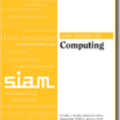The transversal hypergraph problem is the task of enumerating the minimal hitting sets of a hypergraph. It is a long-standing open question whether this can be done in output-polynomial time. For hypergraphs whose solutions have bounded size, Eiter and Gottlob [SICOMP 1995] gave an algorithm that runs in output-polynomial time, but whose space requirement also scales with the output size. We improve this to polynomial delay and polynomial space. More generally, we present an algorithm that on $n$-vertex, $m$-edge hypergraphs has delay $O(m^{k^*+1} n^2)$ and uses $O(mn)$ space, where $k^*$ is the maximum size of any minimal hitting set. Our algorithm is oblivious to $k^*$, a quantity that is hard to compute or even approximate. Central to our approach is the extension problem for minimal hitting sets, deciding for a set $X$ of vertices whether it is contained in any solution. With $|X|$ as parameter, we show that this is one of the first natural problems to be complete for the complexity class $W[3]$. We give an algorithm for the extension problem running in time $O(m^{|X|+1} n)$. We also prove a conditional lower bound under the Strong Exponential Time Hypothesis, showing that this is close to optimal. We apply our enumeration method to the discovery problem of minimal unique column combinations from data profiling. Our empirical evaluation suggests that the algorithm outperforms its worst-case guarantees on hypergraphs stemming from real-world databases.
翻译:跨纬度高挑问题是计算高光学最低击球量的任务。 这是一个长期存在的问题, 这个问题能否在输出- Polynomial 时间里完成 。 对于其解决方案已约束大小的高光仪, Eiter 和 Gottlob [ SICOMP 1995] 给出了一个在输出- Polynomial 时间里运行的算法, 但其空间要求也以输出大小为尺度。 我们将此改进为多元延迟和多元空间。 更一般地说, 我们展示了一个在美元- verversex 上, $$ 的顶值高光学计算会延迟 $(määkä ⁇ 1} n ⁇ 2} 美元, 并使用 $(mn) 美元(m) 美元(m) 美元(m) 美元(m), 并且使用美元(m) 美元(m) 美元(m) 的超高光速计算空间空间。 我们的算法会显示, 最起码的直径直径直径直径直达一个问题。
相关内容
- Today (iOS and OS X): widgets for the Today view of Notification Center
- Share (iOS and OS X): post content to web services or share content with others
- Actions (iOS and OS X): app extensions to view or manipulate inside another app
- Photo Editing (iOS): edit a photo or video in Apple's Photos app with extensions from a third-party apps
- Finder Sync (OS X): remote file storage in the Finder with support for Finder content annotation
- Storage Provider (iOS): an interface between files inside an app and other apps on a user's device
- Custom Keyboard (iOS): system-wide alternative keyboards
Source: iOS 8 Extensions: Apple’s Plan for a Powerful App Ecosystem





